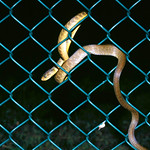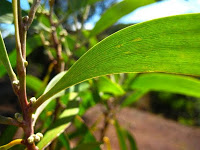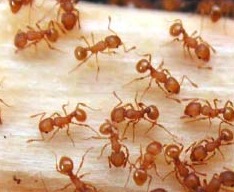Invasive Species
The term “invasive species” is used in a variety of ways, but in Hawaii this term typically refers to species that are both

The brown tree snake is not yet in Hawaii, but has decimated bird populations on Guam. Image courtesy USDA
- harmful to the environment, economy, and/or human health, and
- not native to Hawaii (i.e., species that were introduced by human assistance rather than by their own means of introduction).
It is important to note that not all nonnative species are considered invasive, only those that cause environmental or economic harm, or harm to human health. While there is currently no official designation of invasive species in Hawaii, the HISC is working on an effective way to define and classify these species for the State of Hawaii. Federally, Executive Order 13112 authorized by President Bill Clinton defines invasive species as “alien species whose introduction does or is likely to cause economic or environmental harm or harm to human health.”
Invasive Species as a Problem in Hawaii
Hawaii is a very unique place, due in part to its geographic isolation and volcanic origin. What we refer to as Hawaii’s native plant and animal species are those that arrived here without the assistance of humans: seeds for Hawaii’s first plants arrived here by floating on the waves, being blown by the wind, or transported by traveling birds. Likewise, Hawaii’s native animal species are those that flew here on the wind or swam here on the water. Introduction events like these are very rare, and so the species that made it to Hawaii lived here in relative isolation over the 70 million years of Hawaii’s volcanic history. Those original introductions spawned, through the course of evolution, native Hawaiian species that are often found nowhere else in the world. Our ʻōhiʻa and koa forests are uniquely Hawaiian, as are the hoary bats, ‘i‘iwi, and ‘apapane that once filled those forests.
Species that evolve on islands do so in the absence of some of the world’s more competitive species, such as sharp-hooved ungulates, carnivorous predators, or thorny or toxic plants. Because island species do not have to defend themselves against such threats, they lose (or fail to evolve) the defensive mechanisms often found in their distant mainland relatives. The result is a relatively benign environment: the koa is a thorn-less species of the genus Acacia, distantly related to the more prickly acacias found elsewhere in the world. Likewise, birds in pre-contact Hawaii could nest on the ground, since they didn’t have to worry about predators.
The problem, then, arises when we bring nonnative, competitive species from other parts of the world into our Hawaiian ecosystems. In today’s globalized society, it’s easy for humans to move species from one place to another, and this has resulted in the introduction of species such as deer, goats, ants, coqui frogs, miconia, and others into Hawai‘i. Hawaii’s native species haven’t evolved to compete and coexist with these species, and the result is that these new introductions become “invasive.”
-
The effects of invasive species are wide ranging. Miconia, an invasive plant from South America, quickly spreads throughout forests and prevents the growth of other plants, increasing the risk of erosion with its shallow root systems. Axis deer browse on a variety of native plants and agricultural goods, and their hooves break up soil and increase erosion. Little Fire Ants infest beach parks, homes, and habitats for native species, resulting in painful stings, lost crops, and injured pets. If brown tree snakes were introduced to Hawaii, they could potentially cause the extinction of our native bird species, and could cost an estimated $2.14 billion a year in damages to electrical infrastructure and medical costs associated with snake bites.
Official Designation of Invasive Species
The HISC is in the process of drafting and adopting administrative rules to formally define species that are invasive in Hawaii. While no official designation currently exists, the species listed below are a sample of high-profile species that are informally considered to be invasive due to their ability or potential to cause harm to Hawaii’s environment, economy, or way of life. The description of these species as “invasive” is for educational purposes and is not related to regulatory restrictions. Our website has more information on the legal status of invasive species in Hawaii and current regulations in place to protect Hawai‘i from harmful species.

